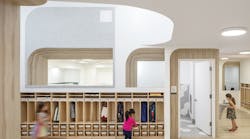The CPTP report shows that the efficacy of tested LED luminaires was significantly lower than the efficacy values of the LEDs used. The report expresses concern that, at this early stage in the development of the SSL market, product performance data should not be used misleadingly.
The testing labs followed test procedures specified in LM-79 draft 2 (IESNA Guide for Electrical and Photometric Measurement of Solid-State Lighting Products). Results are shown in the Table.
Many datasheets for LED luminaires state the luminous efficacy of the LEDs contained within. For the tested luminaires, these values were in the range of 36-55 lm/W. However, testing showed that the luminaire efficacy was significantly lower, in the range of 11.6-19.3 lm/W.
The DOE concludes that it is inappropriate to suggest that a high LED efficacy (lamp efficacy) indicates that a luminaire using those LEDs has high efficacy. This result comes as no surprise to those familiar with working with LEDs, but it represents an important lesson for the lighting industry as a whole. Traditionally, when using incandescent or fluorescent light sources, lamp efficacy provides a good measure of the luminaire performance. However, with LEDs, the use of traditional lighting performance metrics (primarily based on lamp efficacy) could be misleading if used to compare light output or energy efficiency of an SSL product with a product using another light source.
The CPTP report says that measures of LED efficacy can be useful to evaluate the performance of available components. However, it adds, "these data should not be used in product literature for luminaires to convey an indication of the performance of the luminaire at this time."
Looking at the results in the Table, the LED downlights delivered less light than incandescent or fluorescent alternatives, while the efficacy of the LED luminaire falls between comparable incandescent and fluorescent values. Similar results were seen for the under-cabinet light. In the task lighting category, further work is required to evaluate the directional characteristics of the LED products.
Industry groups, standards organizations and the DOE are working quickly to fill the voids in product standards and testing procedures for SSL technologies, says the CPTP report. However, in the meantime, players in the field of SSL technology have a duty to protect the potential of SSL by ensuring that performance claims are accurate, representing the entire luminaire, and do not mislead buyers and possibly cause long-term damage to the SSL market.
Further testing is planned within the CPTP to gain a clearer understanding of how to assess the performance of SSL products compared with traditional lighting sources, to identify how different testing procedures may affect results, and to clarify how traditional photometric practices apply or do not apply to SSL products.




